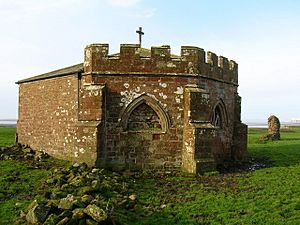Cockersand Abbey facts for kids
Quick facts for kids Cockersand Abbey |
|
|---|---|

The chapter house
|
|
| Location | Thurnham, Lancashire |
| Official name: Cockersand Premonstratensian Abbey | |
| Designated | 13 January 1915 |
| Reference no. | 1018919 |
|
Listed Building – Grade I
|
|
| Official name: The Chapter House, Cockersand Abbey | |
| Designated | 2 May 1968 |
| Reference no. | 1362525 |
| Lua error in Module:Location_map at line 420: attempt to index field 'wikibase' (a nil value). | |
Cockersand Abbey is an old monastery (a place where monks or nuns live) located near Cockerham in Lancashire, England. It sits close to where the River Cocker meets the sea.
This special place started before 1184 as a hospital called St. Mary on the Marsh. It was connected to Leicester Abbey. Later, around 1190, a powerful person named Theobald Walter, 1st Baron Butler changed it into a Premonstratensian priory (a smaller type of monastery). By 1192, it became a full abbey. It also kept helping people as a hospital. The abbey was built on marshy land, which was later drained. This is why it was sometimes called St. Mary's of the Marsh.
Contents
What Happened to Cockersand Abbey?
The Abbey's End
Cockersand Abbey was closed down in 1539 during a time called the Dissolution of the Monasteries. This was when King Henry VIII closed many monasteries in England. After it closed, a man named John Kitchen bought the land.
What You Can See Today
Today, the abbey site is next to a farmhouse. The most important part that is still standing is the chapter house. This building was finished around 1230. A chapter house is where the monks would meet for important discussions.
For many years, in the 1700s and 1800s, the Dalton family from Thurnham Hall used the chapter house as their family mausoleum (a building where people are buried). The Daltons bought the land after 1556. You can also see some small parts of the old church nearby.
Some people used to think that the old wooden choir stalls in Lancaster Priory came from Cockersand Abbey. However, this idea has been shown to be incorrect.
Protecting the Historic Site
The chapter house is a very important historical building. It is a Grade I listed building, which means it has special historical importance. It is also a Scheduled Ancient Monument, which gives it legal protection.
In 2007, a group called English Heritage gave £80,000 to the owner. This money helped to keep the building safe and in good condition. You can sometimes visit the chapter house on special days, like Heritage Open Days.
Ancient Discoveries Near the Abbey
In 1718, two small Roman silver statues were found near the abbey site. This discovery suggests that there might have been a Roman-British shrine (a place of worship) in the area a very long time ago.
Images for kids




